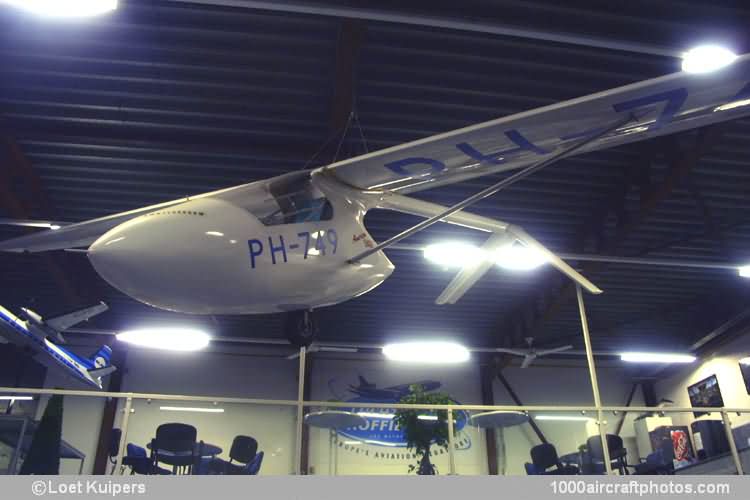Design of the American Eaglet began in September 1974, construction of the prototype started in the following June, which was registered as N101EA (c/n 001) on September 25, and made its first flight on November 19, 1975. The aircraft was intended for amateur construction, and by early 1980 a total of 400 kits had been ordered. At least 26 have been registered in the USA.
PH-749 was registered in the Netherlands on August 29, 1984. On January 9, 1991 the engine was removed, and three months later, April 11, the aircraft had an accident at the gliding center Terlet near Arnhem, and on April 23 the registration was cancelled. After being stored for a period of time the aircraft is preserved at the Luchtvaart Hobby Shop (Aviation Hobby Shop), an aviation mega store in the close proximity of Amsterdam International Airport Schiphol.
Type: Single-seat self-launching sailplane.
Wings: Shoulder-wing monoplane, with single aluminum tube bracing strut on each side. Wing section Wortmann FX-61-184. Dihedral 1° 30' from roots. Incidence 3°. No sweepback. Sparless stressed-skin structure with urethane foam core, molded glass fiber leading edges and wing tips, and epoxy-bonded pre-cured glass fiber skin. 'Spoilerons' (for both roll and glide path control) at 30% chord on each upper surface. No flaps or tabs.
Fuselage: Pod-and-boom structure, the forward portion comprising two pre-formed glass fiber half-shells pop-riveted to a framework of pre-formed tubular aluminum longerons. Tail boom is a thin-wall 6061-T6 aluminum tube with a molded glass fiber tail cone. Combined pitot tube/lifting handle in nose.
Tail unit: Cantilever inverted V-tail plane and elevators, of Wortmann FX-71-L-150/30 section, suspended from rear of tail boom. Tail surfaces have urethane foam core and epoxy/glass fiber skin.
Landing gear: Manually-retractable urethane wheel/tire, with external friction-pad brake, forward of CG. Wheel/tire size 10.5 x 3.5 x 5 in (26.67 x 8.89 x 12.7 cm), pressure 0.83 bars (12 lb/sq.in, 0.85 kg/sq.cm). Tail wheel under tip of each half-tail plane.
Power plant: One 12.2 hp at 8,000 rpm McCulloch 101B single-cylinder two-stroke engine, installed aft of cockpit and driving a two-blade fixed-pitch pusher propeller with folding plastics blades. Recoil starting. Engine is for take off and self-recovery only, and not for cross-country continuous operation. Fuel tank capacity 0.5 gal (2 l). Normal fuel load of approx 4 lb (1.81 kg) (consumption at max power is 12 lb/hr, 5.5 kg/hr) is sufficient for one take off and climb to 2,000 ft (610 m) and three airborne restarts and climbs from 500 ft (150 m) to 2,000 ft (610 m).
Accommodation: Single canvas sling seat under one-piece flush-fitting canopy of vacuum-formed butyrate."
